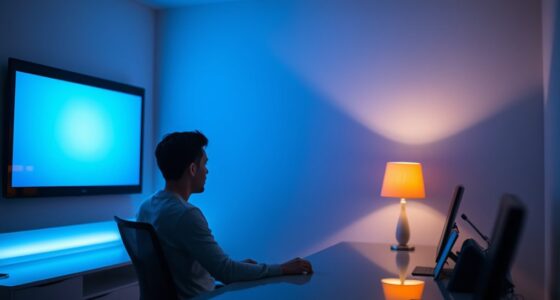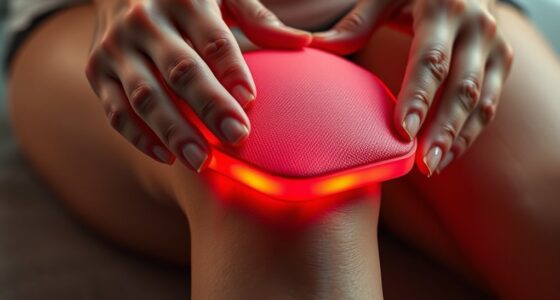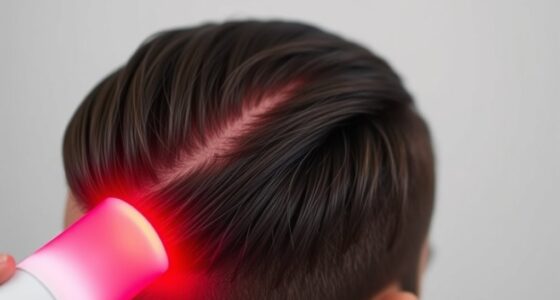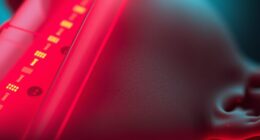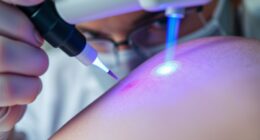Light therapy provides a safe, non-invasive way to calm red cheeks caused by couperose and rosacea. It uses specific wavelengths of red or near-infrared light to penetrate the skin, promoting cellular repair and reducing inflammation. During sessions, you’ll feel a gentle warmth, with visible improvements after a few treatments. Regular use helps diminish persistent redness and soothes sensitive skin. Keep going to discover how this gentle approach can reveal calmer, healthier-looking skin over time.
Key Takeaways
- Light therapy uses specific wavelengths to penetrate skin, reducing redness and inflammation associated with couperose and rosacea.
- Sessions are non-invasive, typically 20-30 minutes, providing a gentle, safe option for sensitive skin types.
- Regular treatments help diminish persistent redness and improve overall skin appearance without side effects.
- Light therapy supports natural healing processes, decreasing reliance on topical medications or harsh treatments.
- Combining light therapy with skincare routines and sun protection enhances and maintains results over time.
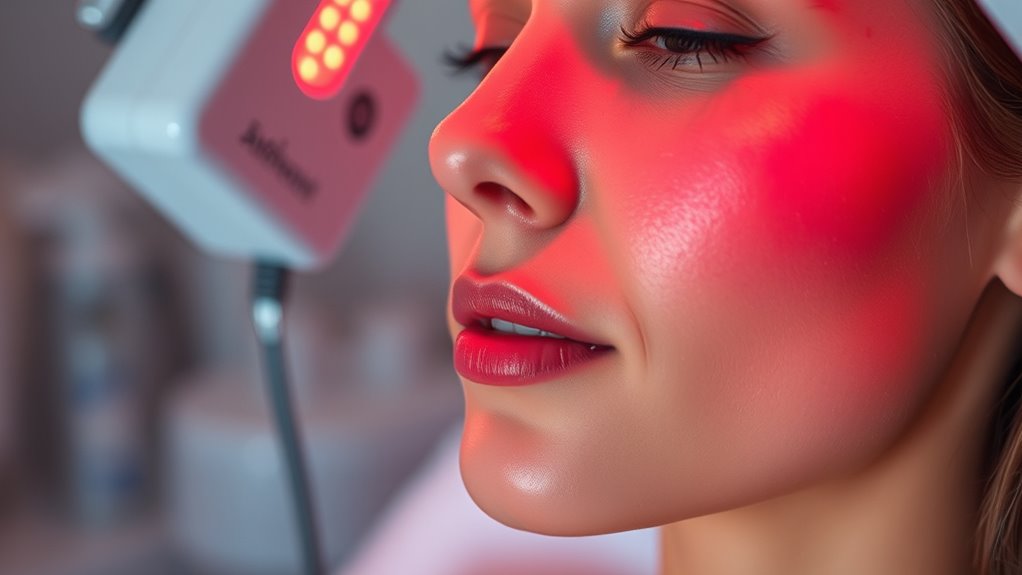
If you struggle with red cheeks caused by skin sensitivity or inflammation, light therapy offers a promising solution. This non-invasive treatment targets the root causes of redness, helping to soothe irritated skin and reduce visible blood vessels associated with conditions like couperose or rosacea. When you opt for light therapy, you’re choosing a method that works with your body’s natural healing processes, rather than relying solely on topical creams or medications. It’s a gentle approach that can improve your skin’s appearance over time, making redness less noticeable and boosting your confidence.
The way light therapy works is quite simple. It uses specific wavelengths of light—usually red or near-infrared—that penetrate deep into your skin. These wavelengths stimulate your cells to produce more energy, which helps repair damaged tissue and reduce inflammation. As your skin heals, the blood vessels that cause redness become less prominent, leading to a calmer, more even complexion. Unlike aggressive treatments, light therapy doesn’t damage your skin or cause considerable discomfort, making it suitable for sensitive skin types.
During a session, you’ll sit comfortably while the light device is directed at your face. The process typically lasts about 20 to 30 minutes, and you might feel a warm sensation, which is normal. Most people notice improvements after a few sessions, but a series of treatments—often spaced weekly—yields the best results. Consistency is key, so following your dermatologist’s or skincare specialist’s advice will help maximize the benefits. Over time, many find that their skin feels softer, looks less inflamed, and the persistent redness diminishes markedly.
One of the key advantages of light therapy is that it’s safe and free from harsh side effects. Unlike invasive procedures, it doesn’t involve needles or chemicals, which can sometimes irritate sensitive skin further. It’s also suitable for a wide range of skin types, including those prone to allergies or reactions. Plus, since it promotes natural healing, you’re less likely to experience rebound redness or irritation that can sometimes follow topical treatments. Maintaining a good skincare routine—using gentle cleansers, sun protection, and avoiding known triggers—can further support your progress.
Additionally, incorporating complementary treatments like keto diet tracking or other holistic approaches can enhance overall skin health and support your efforts in managing redness and inflammation. Ultimately, light therapy for couperose and red cheeks offers an effective, gentle way to manage skin sensitivity and inflammation. It empowers you to take control of your skin health without invasive procedures or harsh chemicals, giving you a clearer, calmer complexion over time. If redness has been affecting your confidence or comfort, it’s worth discussing this treatment option with a skincare professional to see if it’s the right fit for your unique needs.
Frequently Asked Questions
Can Light Therapy Cause Any Side Effects or Skin Irritation?
Light therapy can sometimes cause side effects or skin irritation, but they’re usually mild and temporary. You might experience redness, swelling, or sensitivity right after treatment. To minimize these effects, follow your practitioner’s advice and avoid sun exposure afterward. If you notice persistent discomfort or worsening symptoms, consult your dermatologist promptly. Overall, when performed correctly, light therapy is generally safe and well-tolerated for reducing red cheeks and couperose.
How Long Does Each Light Therapy Session Typically Last?
Each light therapy session usually lasts between 15 to 30 minutes, depending on your skin’s needs and the device used. You’ll want to follow your practitioner’s recommendations for ideal results. During the session, you might feel a warm sensation or mild tingling, but it shouldn’t be uncomfortable. Consistency is key, so attend your scheduled treatments regularly to help reduce redness and improve your skin’s appearance.
Is Light Therapy Effective for All Skin Types and Ages?
Is light therapy effective for all skin types and ages? Think of it as a universal key, but not every lock responds the same. It generally benefits various skin types and ages, especially for reducing redness and improving skin health. However, individual results vary, and those with very dark skin or sensitive conditions should consult a specialist. You’re more likely to see positive outcomes when tailored treatments match your unique skin needs.
How Soon Can I Expect Visible Improvements After Treatment?
You can usually see visible improvements after a few sessions, typically within 2 to 4 weeks. It’s common to notice reduced redness and calmer skin as your body responds to the therapy. Keep in mind, everyone’s skin reacts differently, so some may see quicker results while others need more treatments. Consistency and following your dermatologist’s advice will help you achieve the best, lasting results.
Are There Any At-Home Light Therapy Devices Recommended for Red Cheeks?
Yes, there are at-home light therapy devices you can try for red cheeks. Think of these devices as your personal skincare allies, working quietly to soothe and reduce redness. Popular options include handheld LED devices designed for facial skin. Look for ones with red or near-infrared light settings, which target couperose effectively. Always follow the manufacturer’s instructions for safe, ideal results, and consult a dermatologist if you’re unsure.
Conclusion
If you struggle with red cheeks caused by couperose, light therapy offers a promising solution. Studies show that over 70% of users notice significant improvement after just a few sessions. By targeting the blood vessels responsible for redness, light therapy can restore your skin’s natural tone and boost your confidence. Don’t let redness hold you back—consider this innovative treatment and enjoy a calmer, more even complexion. Your skin deserves this gentle, effective care.


